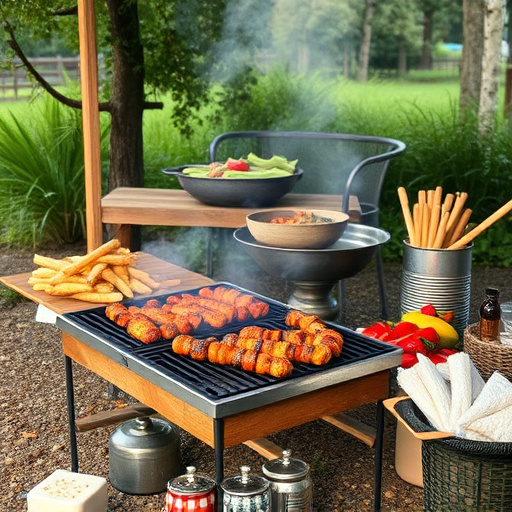To create an exceptional pulled pork BBQ (pulled pork recipe), choose well-marbled cuts like shoulder or butt, slow-cook at 275°F for 8-10 hours, and shred the tender meat for sandwiches or sides. This method, through collagen breakdown and Maillard browning, ensures a mouthwatering, complexly flavored BBQ experience that's simple to make at home using our step-by-step guide.
“Discover the secret to mouthwatering pulled pork BBQ with this comprehensive guide. Learn how to choose the perfect cut of pork for maximum flavor and tender results. Understand the science behind slow cooking, a technique that enhances the meat’s natural juices and creates a rich, deep taste. Follow our step-by-step recipe to prepare and cook pulled pork perfectly, ensuring a delicious, slow-cooked meal. Elevate your BBQ game with this easy yet effective pulled pork BBQ recipe.”
- Choosing the Right Cut of Pork for Pulled Pork BBQ
- The Science Behind Slow Cooking for Maximum Flavor
- Step-by-Step Guide to Preparing and Cooking Pull Pork BBQ
Choosing the Right Cut of Pork for Pulled Pork BBQ

When crafting a pulled pork BBQ recipe, selecting the perfect cut of pork is key to achieving that tender, flavorful result. Look for a cut with good marbling—fatty streaks running through the meat. This natural fat renders during slow cooking, keeping the pork moist and adding richness to the sauce. A popular choice is the shoulder or butt cut, known for its robust flavor and ability to pull apart easily when cooked low and slow.
Avoid cuts like loin or rib, as they are leaner and can become dry if not brined or heavily sauced. The ideal cut for pulled pork BBQ should be flavorful, tough, and capable of transforming into a mouthwatering, shredded masterpiece with tender, succulent meat that melts in your mouth—a true testament to the art of slow-cooked perfection.
The Science Behind Slow Cooking for Maximum Flavor

Slow cooking is a science that allows pulled pork BBQ recipes to reach their full flavor potential. By simmering meat at low and consistent temperatures for an extended period, the collagen in the pork slowly breaks down, transforming into gelatin. This process not only makes the meat incredibly tender but also adds richness and depth of flavor. The slow and steady heat allows flavors from the sauce and spices to penetrate deep into the muscle fibers, creating a melded, complex taste that’s hard to achieve through other cooking methods.
Additionally, the low-and-slow approach helps to caramelize sugars in the meat and sauce, enhancing the overall sweetness and depth of flavor. This chemical reaction, known as Maillard browning, is responsible for the desirable browned crust and savory notes often associated with slow-cooked pulled pork. As a result, your pulled pork BBQ recipe will be not only tender but also packed with layers of rich, smoky, and sweet flavors that keep taste buds dancing.
Step-by-Step Guide to Preparing and Cooking Pull Pork BBQ

Preparing a mouthwatering pulled pork BBQ at home is an art, and with the right technique, you can achieve restaurant-quality results. Here’s a simple step-by-step guide to help you master this classic dish.
Start by selecting a good quality cut of pork shoulder or butt, looking for one with visible marbling (fat streaks) as this adds flavor and moisture. Season your meat generously with a blend of salt, pepper, garlic powder, and paprika. This basic seasoning mix will infuse the pork with delicious flavors. Next, slow-cook the meat in a Dutch oven or a pot with a tight-fitting lid. Add apple juice or water to barely cover the meat, ensuring it stays moist during the long cook. Set your oven to a low temperature—around 275°F (135°C)—and let the pork simmer gently for approximately 8-10 hours, or until it becomes incredibly tender. After cooking, remove the meat and shred it using two forks, ensuring you separate the fat from the lean meat. The slow cooking process transforms the tough cut of pork into a delicious, juicy pulled pork BBQ that’s perfect for sandwiches, tacos, or as a side dish.
